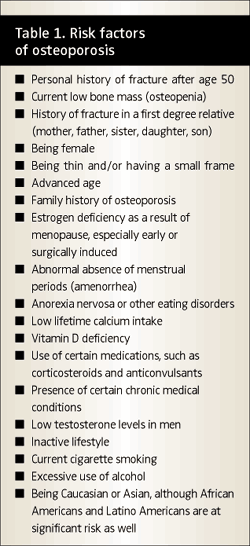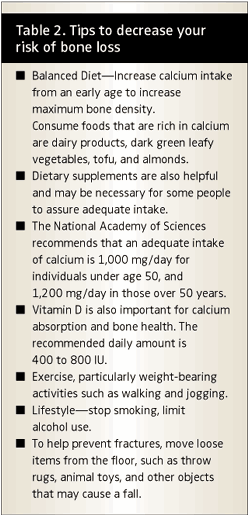
Building Bones
Osteoporosis is a serious health risk, especially for women, yet it is highly preventable.
Bones are living, growing tissue that are constantly remodeling. The majority of bone mass is developed during the adolescent and young adulthood years, with nearly 90% of skeletal mass accumulated by age 18.1 Osteoporosis—porous bones due to severe bone loss—is a major public health threat and affects approximately 44 million Americans, or 55% of the people 50 and older.2
Osteopenia—low bone density,—affects many others. The cost to society is more than $17 billion per year.2 As bone density decreases, the bones become weaker and more likely to fracture. Both men and women experience progressive decrease in bone density as they age. However, it occurs four times more often in women than men.2
Women can lose up to 20% of their bone mass in the 5 to 7 years following menopause, making them more susceptible to osteoporosis.1 The expectation is that more than 41 million women worldwide will be affected within the next 20 years if current trends are not reversed.1

Soft Drinks, Soft Bones
In 2000, Americans spent $60 billion on carbonated soft drinks, and billions more on noncarbonated “fruit” beverages. During the same year, the average American consumed more than 53 gallons of soft drinks.3
The average 12 oz (360 ml) can of soda pop contains about 40 grams of refined sugars or 10 teaspoons of pure sugar.4 Diets high in refined sugars can promote tooth decay, as well as obesity, which increases the risk of diabetes, high blood pressure, stroke, and heart disease. Excessive consumption of soft drinks can cause increased acid levels throughout the body, which can cause gastrointestinal distress.
A Harvard study showed that active girls who drink cola drinks are five times more likely to have bone fractures than girls who do not drink soda pop.5 Drinking any type of carbonated beverage increased the likelihood of having a bone fracture and the greatest increases were for those who drank cola beverages and reported their physical activity as either high-level or vigorous. In two previous studies, the first on postmenopausal women, the second on teenagers, the investigator consistently found strong relationships between consumption of carbonated beverages and bone fractures in physically active populations.6
Why do soft drinks, especially cola beverages, possibly increase the fracture rate? Cola drinks contain phosphoric acid, which has previously been shown to affect calcium metabolism and bone mass.4 The body needs a balanced calcium/phosphorus ratio, along with other minerals and proteins for healthy bones. The large amounts of phosphorus and phosphoric acid found in soft drinks can cause calcium to be drawn from the bones in order to keep the blood ratio in balance. When you have phosphoric acid (especially in a cola beverage), the excess phosphoric acid binds to calcium in the stomach, which keeps the calcium from being absorbed. This effect is also seen with diet and caffeine-free cola beverages, but not with noncola carbonated beverages.
In addition, the caffeine and sugar, found in most soft drinks, may add to bone destruction by leaching even more calcium from the bones. Another explanation for bone loss is that young people may be replacing milk or other nutritious drinks with soda pop, giving their growing bodies less calcium. The high consumption of carbonated beverages and the declining consumption of milk are of great public health significance for girls and women because of their tendency for osteoporosis in later life. This calcium/phosphorus ratio can be maintained with a diet rich in legumes, vegetables, and fruits, and a minimum of soft drinks. Dental hygienists should instruct clients to NEVER put soft drinks in a baby’s bottle!
Diagnosis
Tests can measure bone strength and the risk of fracture. One test measures your bone mineral density (BMD), and another measures other structural features of bone.
The two main types of tests measuring bone strength are:
Radiography. Radiation is used to determine bone density. The procedure takes up to 20 minutes and results in about as much radiation exposure as a standard x-ray.
Ultrasound. Sound waves are used to measure bone structure, so there is no radiation exposure. The procedure can be completed generally in less than 10 minutes.

Skeletal Bone Density
Alveolar bone loss and tooth loss are well-documented consequences of periodontitis, but there is less evidence demonstrating an association between periodontitis and skeletal bone density. In an arm of the National Health and Nutrition Examination Survey III (NHANES), researchers at the University of Buffalo found a strong and direct relationship between bone loss, periodontitis, and tooth loss.7 Systemic bone loss may be a factor in tooth loss due to increased thinning of alveolar bone. Due to this association between skeletal bone loss and tooth loss, dental x-rays may serve as good screening tools for osteoporosis. Researchers at the University of Washington School of Dentistry found dental x-rays to be a highly effective method for distinguishing clients with osteoporosis from clients with normal bone density.8,9 Therefore, as dental hygienists, we can render preventive care that can save more than your teeth!
The Estrogen Connection
The role of estrogen in osteoporosis prevention and treatment is well established. It is not apparent what effect estrogen has on alveolar bone density, tooth loss, and periodontitis, but it appears that estrogen deficient women have a greater loss in alveolar bone density. This loss of density leaves the bone more susceptible to periodontal bacteria, increasing the risk for periodontitis and tooth loss. Replacement estrogen may help minimize tooth loss in postmenopausal women. Some studies found that estrogen users preserved higher numbers of teeth than nonusers, and that the longer the estrogen use, the less tooth loss. However, based on the results of the recent Women’s Health Initiative Study (WHI), estrogen should be used with caution as more risks were found with its use than benefits.
Preventive health care can later save time, pain, money, and prolong life. A physician or nurse practitioner can share practical approaches to prevention, diagnosis, and management of osteoporosis. We now know that dental hygienists are a vital part of the prevention team. By being aware of the oral/systemic connection, dental hygienists can forewarn clients about potential life threatening problems, such as osteoporosis, oral cancer, and other diseases. Dental hygienists can save lives!
REFERENCES
- Kass-Wolff J H. Calcium in women: healthy bones and much more. J Obstet Gynecol Neonatal Nurs. 2004;33:21-33.
- National Osteoporosis Foundation. Available at: www.nof.org. Accessed May 10, 2004.
- National Soft Drink Association. Available at: www.nsda.org/softdrinks/History/funfacts.html. Accessed May 10, 2004.
- Mercola J, Droege R. The real dangers of soda to you and your children. Available at: www.mercola.com/2003/jul/9/soda_dangers.htm. Accessed May 12, 2004.
- Wyshak G. Teenaged girls, carbonated beverage consumption, and bone fractures. Arch Pediatr Adolesc Med. 2000;154:610-613.
- Wyshak G, Frisch RE. Carbonated beverages, dietary calcium, the dietary calcium/phosphorus ratio, and bone fractures in girls and boys. J Adolesc Health. 1994;15:210-215.
- Krejci CB, Bissada NF. Women’s health issues and their relationship to periodontitis. J Am Dent Assoc. 2002;133(3):323-329.
- Tozum TF, Taguchi A. Role of dental panoramic radiographs in assessment of future dental conditions in patients with osteoporosis and periodontitis. NY State Dent J. 2004;70(1):32-35.
- National Institutes of Health Osteoporosis and Related Bone Disease National Resource Center. Oral Manifestations of Bone Los. Available at: www.osteo.org. Accessed May 12, 2004.

